Matriarchy vs. Patriarchy: A Study of the Mosuo Social Structure
VerifiedAdded on 2022/09/25
|7
|1826
|25
Essay
AI Summary
This essay delves into the social organization of the Mosuo people of Yunnan Province, China, focusing on their unique blend of matriarchal and patriarchal elements. It begins by introducing the Mosuo and their agrarian lifestyle, highlighting their traditional practices like walking marriages and the roles of men and women. The essay then distinguishes between matriarchy and matrilineality, clarifying that while the Mosuo exhibit matrilineal descent, their society is not a true matriarchy due to the political influence of men. It contrasts matriarchal and patriarchal societal structures, emphasizing the different power dynamics and gender roles. The essay further examines the impact of modernization on the Mosuo way of life, including the erosion of traditional family structures, the rise of nuclear families, and the challenges posed by tourism. The conclusion reiterates the key aspects of Mosuo society and the effects of external influences, emphasizing the changes and challenges faced by this unique cultural group. The essay uses multiple sources to support its arguments and analysis.
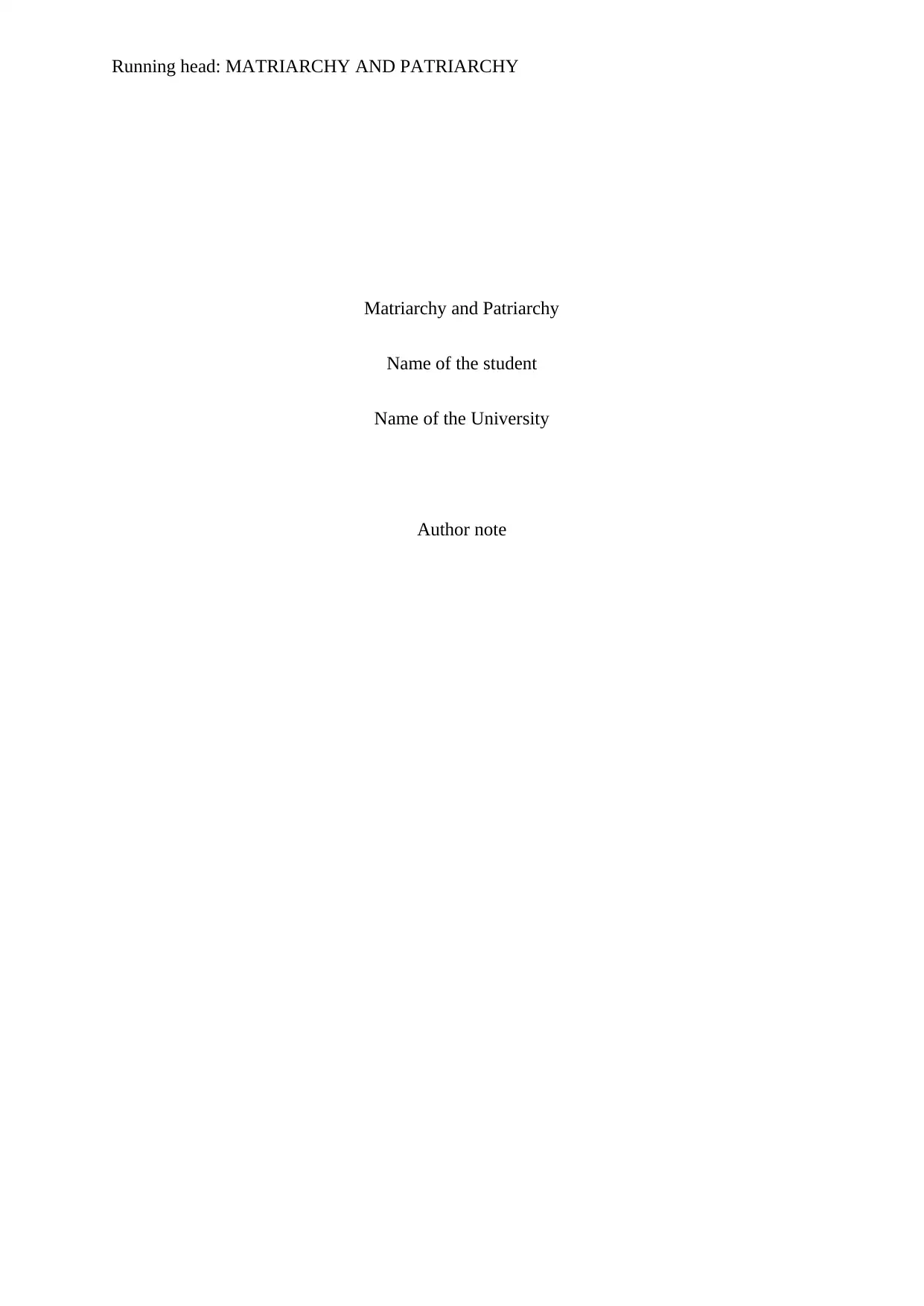
Running head: MATRIARCHY AND PATRIARCHY
Matriarchy and Patriarchy
Name of the student
Name of the University
Author note
Matriarchy and Patriarchy
Name of the student
Name of the University
Author note
Paraphrase This Document
Need a fresh take? Get an instant paraphrase of this document with our AI Paraphraser
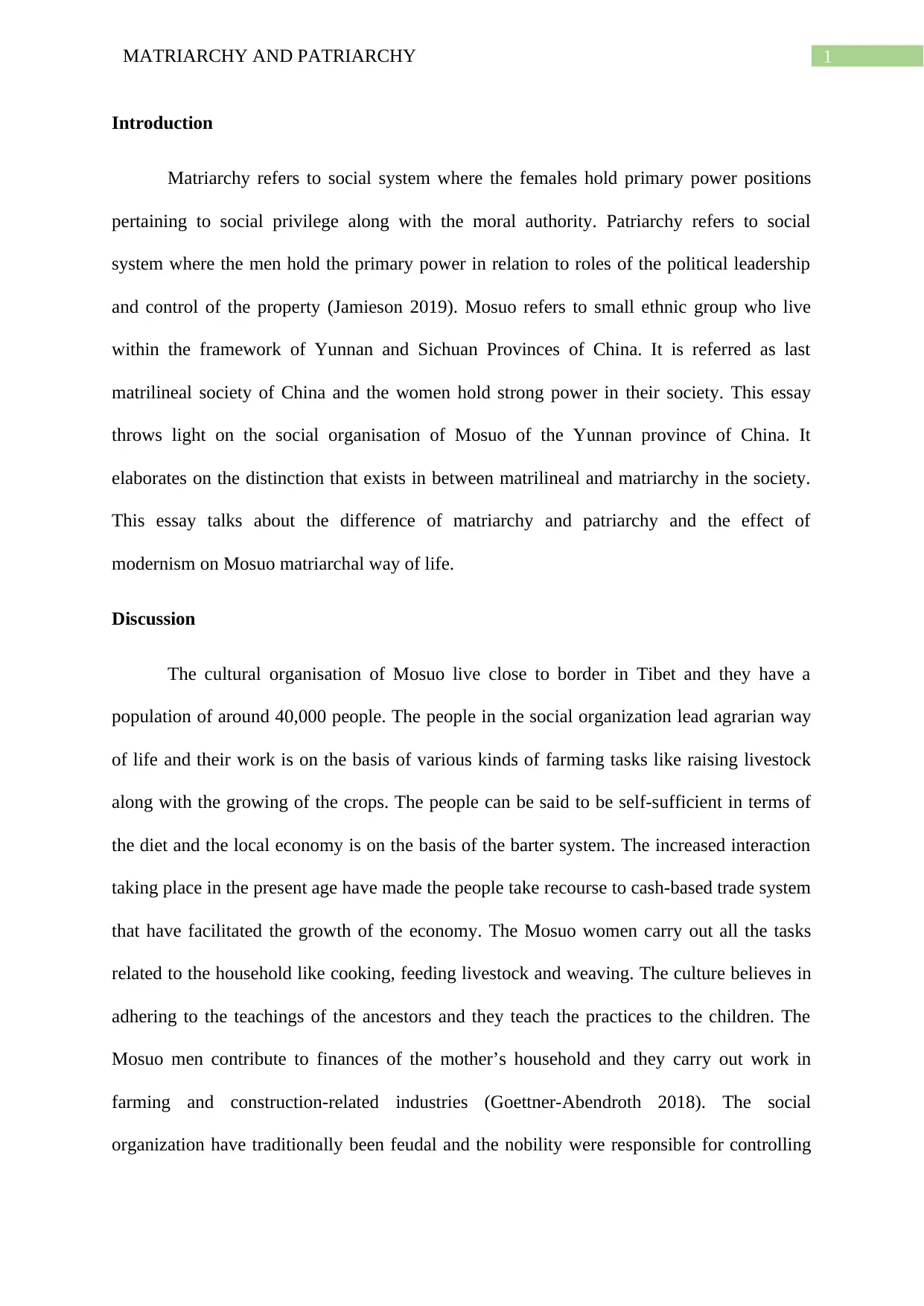
1MATRIARCHY AND PATRIARCHY
Introduction
Matriarchy refers to social system where the females hold primary power positions
pertaining to social privilege along with the moral authority. Patriarchy refers to social
system where the men hold the primary power in relation to roles of the political leadership
and control of the property (Jamieson 2019). Mosuo refers to small ethnic group who live
within the framework of Yunnan and Sichuan Provinces of China. It is referred as last
matrilineal society of China and the women hold strong power in their society. This essay
throws light on the social organisation of Mosuo of the Yunnan province of China. It
elaborates on the distinction that exists in between matrilineal and matriarchy in the society.
This essay talks about the difference of matriarchy and patriarchy and the effect of
modernism on Mosuo matriarchal way of life.
Discussion
The cultural organisation of Mosuo live close to border in Tibet and they have a
population of around 40,000 people. The people in the social organization lead agrarian way
of life and their work is on the basis of various kinds of farming tasks like raising livestock
along with the growing of the crops. The people can be said to be self-sufficient in terms of
the diet and the local economy is on the basis of the barter system. The increased interaction
taking place in the present age have made the people take recourse to cash-based trade system
that have facilitated the growth of the economy. The Mosuo women carry out all the tasks
related to the household like cooking, feeding livestock and weaving. The culture believes in
adhering to the teachings of the ancestors and they teach the practices to the children. The
Mosuo men contribute to finances of the mother’s household and they carry out work in
farming and construction-related industries (Goettner-Abendroth 2018). The social
organization have traditionally been feudal and the nobility were responsible for controlling
Introduction
Matriarchy refers to social system where the females hold primary power positions
pertaining to social privilege along with the moral authority. Patriarchy refers to social
system where the men hold the primary power in relation to roles of the political leadership
and control of the property (Jamieson 2019). Mosuo refers to small ethnic group who live
within the framework of Yunnan and Sichuan Provinces of China. It is referred as last
matrilineal society of China and the women hold strong power in their society. This essay
throws light on the social organisation of Mosuo of the Yunnan province of China. It
elaborates on the distinction that exists in between matrilineal and matriarchy in the society.
This essay talks about the difference of matriarchy and patriarchy and the effect of
modernism on Mosuo matriarchal way of life.
Discussion
The cultural organisation of Mosuo live close to border in Tibet and they have a
population of around 40,000 people. The people in the social organization lead agrarian way
of life and their work is on the basis of various kinds of farming tasks like raising livestock
along with the growing of the crops. The people can be said to be self-sufficient in terms of
the diet and the local economy is on the basis of the barter system. The increased interaction
taking place in the present age have made the people take recourse to cash-based trade system
that have facilitated the growth of the economy. The Mosuo women carry out all the tasks
related to the household like cooking, feeding livestock and weaving. The culture believes in
adhering to the teachings of the ancestors and they teach the practices to the children. The
Mosuo men contribute to finances of the mother’s household and they carry out work in
farming and construction-related industries (Goettner-Abendroth 2018). The social
organization have traditionally been feudal and the nobility were responsible for controlling
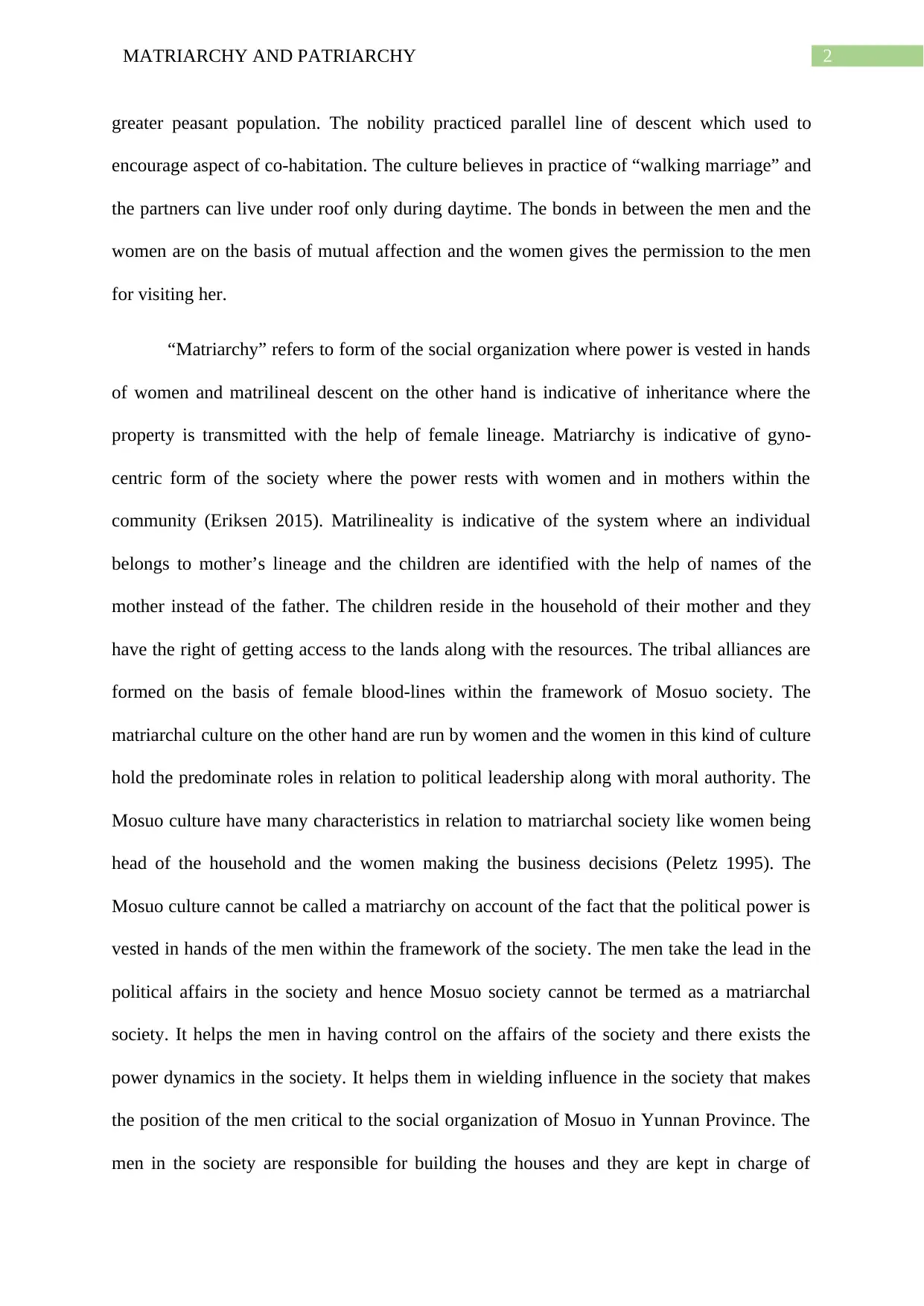
2MATRIARCHY AND PATRIARCHY
greater peasant population. The nobility practiced parallel line of descent which used to
encourage aspect of co-habitation. The culture believes in practice of “walking marriage” and
the partners can live under roof only during daytime. The bonds in between the men and the
women are on the basis of mutual affection and the women gives the permission to the men
for visiting her.
“Matriarchy” refers to form of the social organization where power is vested in hands
of women and matrilineal descent on the other hand is indicative of inheritance where the
property is transmitted with the help of female lineage. Matriarchy is indicative of gyno-
centric form of the society where the power rests with women and in mothers within the
community (Eriksen 2015). Matrilineality is indicative of the system where an individual
belongs to mother’s lineage and the children are identified with the help of names of the
mother instead of the father. The children reside in the household of their mother and they
have the right of getting access to the lands along with the resources. The tribal alliances are
formed on the basis of female blood-lines within the framework of Mosuo society. The
matriarchal culture on the other hand are run by women and the women in this kind of culture
hold the predominate roles in relation to political leadership along with moral authority. The
Mosuo culture have many characteristics in relation to matriarchal society like women being
head of the household and the women making the business decisions (Peletz 1995). The
Mosuo culture cannot be called a matriarchy on account of the fact that the political power is
vested in hands of the men within the framework of the society. The men take the lead in the
political affairs in the society and hence Mosuo society cannot be termed as a matriarchal
society. It helps the men in having control on the affairs of the society and there exists the
power dynamics in the society. It helps them in wielding influence in the society that makes
the position of the men critical to the social organization of Mosuo in Yunnan Province. The
men in the society are responsible for building the houses and they are kept in charge of
greater peasant population. The nobility practiced parallel line of descent which used to
encourage aspect of co-habitation. The culture believes in practice of “walking marriage” and
the partners can live under roof only during daytime. The bonds in between the men and the
women are on the basis of mutual affection and the women gives the permission to the men
for visiting her.
“Matriarchy” refers to form of the social organization where power is vested in hands
of women and matrilineal descent on the other hand is indicative of inheritance where the
property is transmitted with the help of female lineage. Matriarchy is indicative of gyno-
centric form of the society where the power rests with women and in mothers within the
community (Eriksen 2015). Matrilineality is indicative of the system where an individual
belongs to mother’s lineage and the children are identified with the help of names of the
mother instead of the father. The children reside in the household of their mother and they
have the right of getting access to the lands along with the resources. The tribal alliances are
formed on the basis of female blood-lines within the framework of Mosuo society. The
matriarchal culture on the other hand are run by women and the women in this kind of culture
hold the predominate roles in relation to political leadership along with moral authority. The
Mosuo culture have many characteristics in relation to matriarchal society like women being
head of the household and the women making the business decisions (Peletz 1995). The
Mosuo culture cannot be called a matriarchy on account of the fact that the political power is
vested in hands of the men within the framework of the society. The men take the lead in the
political affairs in the society and hence Mosuo society cannot be termed as a matriarchal
society. It helps the men in having control on the affairs of the society and there exists the
power dynamics in the society. It helps them in wielding influence in the society that makes
the position of the men critical to the social organization of Mosuo in Yunnan Province. The
men in the society are responsible for building the houses and they are kept in charge of
⊘ This is a preview!⊘
Do you want full access?
Subscribe today to unlock all pages.

Trusted by 1+ million students worldwide
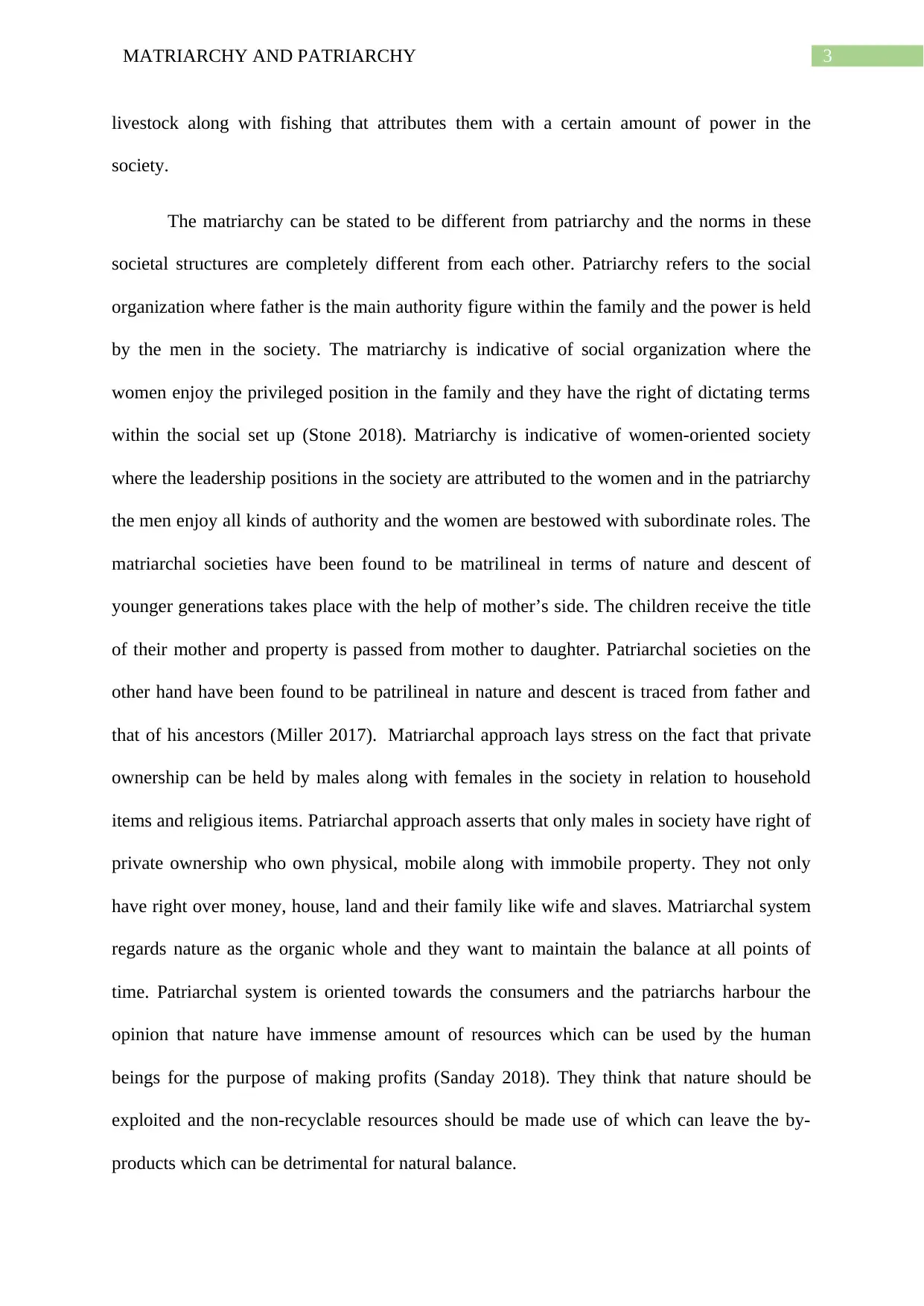
3MATRIARCHY AND PATRIARCHY
livestock along with fishing that attributes them with a certain amount of power in the
society.
The matriarchy can be stated to be different from patriarchy and the norms in these
societal structures are completely different from each other. Patriarchy refers to the social
organization where father is the main authority figure within the family and the power is held
by the men in the society. The matriarchy is indicative of social organization where the
women enjoy the privileged position in the family and they have the right of dictating terms
within the social set up (Stone 2018). Matriarchy is indicative of women-oriented society
where the leadership positions in the society are attributed to the women and in the patriarchy
the men enjoy all kinds of authority and the women are bestowed with subordinate roles. The
matriarchal societies have been found to be matrilineal in terms of nature and descent of
younger generations takes place with the help of mother’s side. The children receive the title
of their mother and property is passed from mother to daughter. Patriarchal societies on the
other hand have been found to be patrilineal in nature and descent is traced from father and
that of his ancestors (Miller 2017). Matriarchal approach lays stress on the fact that private
ownership can be held by males along with females in the society in relation to household
items and religious items. Patriarchal approach asserts that only males in society have right of
private ownership who own physical, mobile along with immobile property. They not only
have right over money, house, land and their family like wife and slaves. Matriarchal system
regards nature as the organic whole and they want to maintain the balance at all points of
time. Patriarchal system is oriented towards the consumers and the patriarchs harbour the
opinion that nature have immense amount of resources which can be used by the human
beings for the purpose of making profits (Sanday 2018). They think that nature should be
exploited and the non-recyclable resources should be made use of which can leave the by-
products which can be detrimental for natural balance.
livestock along with fishing that attributes them with a certain amount of power in the
society.
The matriarchy can be stated to be different from patriarchy and the norms in these
societal structures are completely different from each other. Patriarchy refers to the social
organization where father is the main authority figure within the family and the power is held
by the men in the society. The matriarchy is indicative of social organization where the
women enjoy the privileged position in the family and they have the right of dictating terms
within the social set up (Stone 2018). Matriarchy is indicative of women-oriented society
where the leadership positions in the society are attributed to the women and in the patriarchy
the men enjoy all kinds of authority and the women are bestowed with subordinate roles. The
matriarchal societies have been found to be matrilineal in terms of nature and descent of
younger generations takes place with the help of mother’s side. The children receive the title
of their mother and property is passed from mother to daughter. Patriarchal societies on the
other hand have been found to be patrilineal in nature and descent is traced from father and
that of his ancestors (Miller 2017). Matriarchal approach lays stress on the fact that private
ownership can be held by males along with females in the society in relation to household
items and religious items. Patriarchal approach asserts that only males in society have right of
private ownership who own physical, mobile along with immobile property. They not only
have right over money, house, land and their family like wife and slaves. Matriarchal system
regards nature as the organic whole and they want to maintain the balance at all points of
time. Patriarchal system is oriented towards the consumers and the patriarchs harbour the
opinion that nature have immense amount of resources which can be used by the human
beings for the purpose of making profits (Sanday 2018). They think that nature should be
exploited and the non-recyclable resources should be made use of which can leave the by-
products which can be detrimental for natural balance.
Paraphrase This Document
Need a fresh take? Get an instant paraphrase of this document with our AI Paraphraser
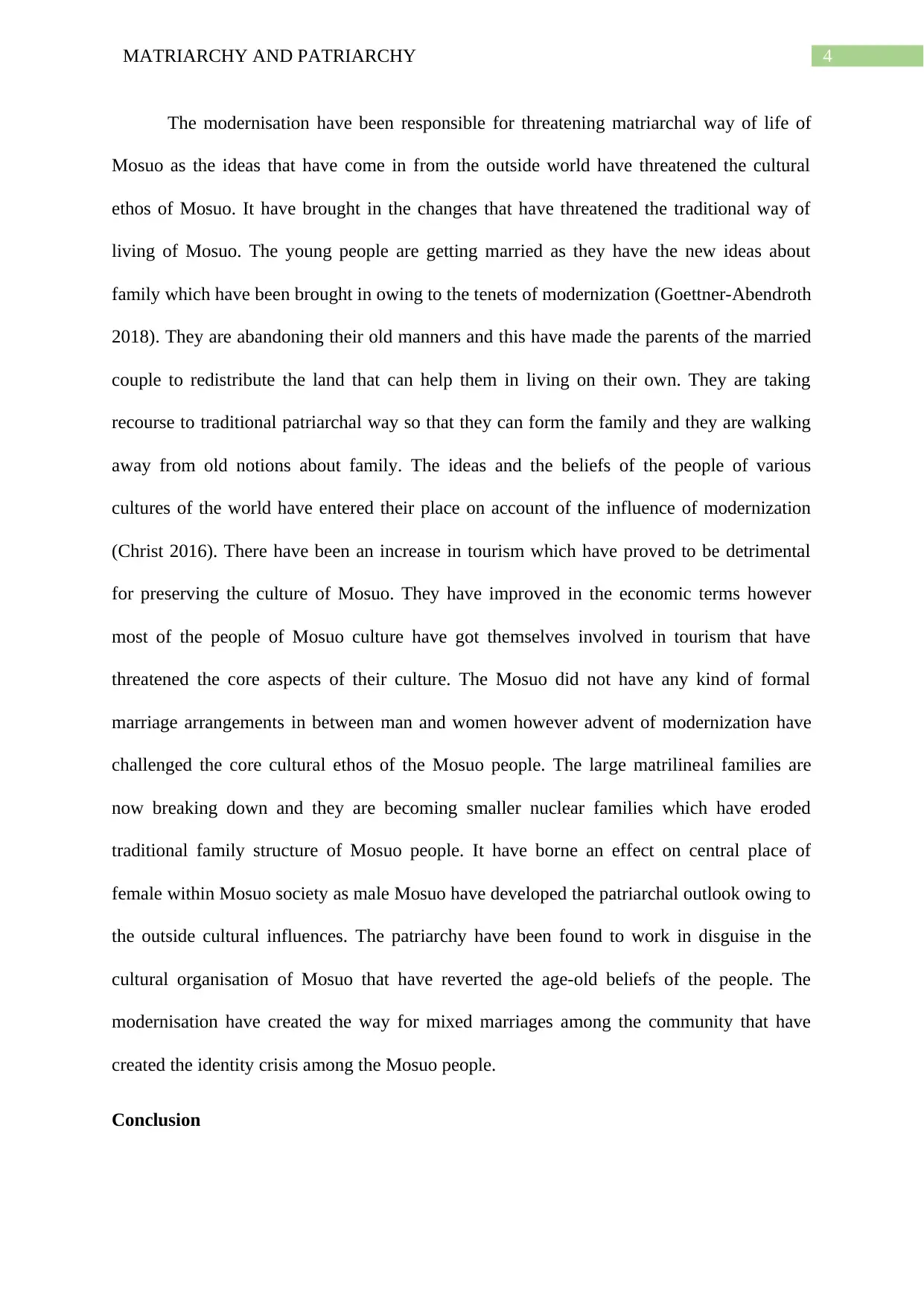
4MATRIARCHY AND PATRIARCHY
The modernisation have been responsible for threatening matriarchal way of life of
Mosuo as the ideas that have come in from the outside world have threatened the cultural
ethos of Mosuo. It have brought in the changes that have threatened the traditional way of
living of Mosuo. The young people are getting married as they have the new ideas about
family which have been brought in owing to the tenets of modernization (Goettner-Abendroth
2018). They are abandoning their old manners and this have made the parents of the married
couple to redistribute the land that can help them in living on their own. They are taking
recourse to traditional patriarchal way so that they can form the family and they are walking
away from old notions about family. The ideas and the beliefs of the people of various
cultures of the world have entered their place on account of the influence of modernization
(Christ 2016). There have been an increase in tourism which have proved to be detrimental
for preserving the culture of Mosuo. They have improved in the economic terms however
most of the people of Mosuo culture have got themselves involved in tourism that have
threatened the core aspects of their culture. The Mosuo did not have any kind of formal
marriage arrangements in between man and women however advent of modernization have
challenged the core cultural ethos of the Mosuo people. The large matrilineal families are
now breaking down and they are becoming smaller nuclear families which have eroded
traditional family structure of Mosuo people. It have borne an effect on central place of
female within Mosuo society as male Mosuo have developed the patriarchal outlook owing to
the outside cultural influences. The patriarchy have been found to work in disguise in the
cultural organisation of Mosuo that have reverted the age-old beliefs of the people. The
modernisation have created the way for mixed marriages among the community that have
created the identity crisis among the Mosuo people.
Conclusion
The modernisation have been responsible for threatening matriarchal way of life of
Mosuo as the ideas that have come in from the outside world have threatened the cultural
ethos of Mosuo. It have brought in the changes that have threatened the traditional way of
living of Mosuo. The young people are getting married as they have the new ideas about
family which have been brought in owing to the tenets of modernization (Goettner-Abendroth
2018). They are abandoning their old manners and this have made the parents of the married
couple to redistribute the land that can help them in living on their own. They are taking
recourse to traditional patriarchal way so that they can form the family and they are walking
away from old notions about family. The ideas and the beliefs of the people of various
cultures of the world have entered their place on account of the influence of modernization
(Christ 2016). There have been an increase in tourism which have proved to be detrimental
for preserving the culture of Mosuo. They have improved in the economic terms however
most of the people of Mosuo culture have got themselves involved in tourism that have
threatened the core aspects of their culture. The Mosuo did not have any kind of formal
marriage arrangements in between man and women however advent of modernization have
challenged the core cultural ethos of the Mosuo people. The large matrilineal families are
now breaking down and they are becoming smaller nuclear families which have eroded
traditional family structure of Mosuo people. It have borne an effect on central place of
female within Mosuo society as male Mosuo have developed the patriarchal outlook owing to
the outside cultural influences. The patriarchy have been found to work in disguise in the
cultural organisation of Mosuo that have reverted the age-old beliefs of the people. The
modernisation have created the way for mixed marriages among the community that have
created the identity crisis among the Mosuo people.
Conclusion
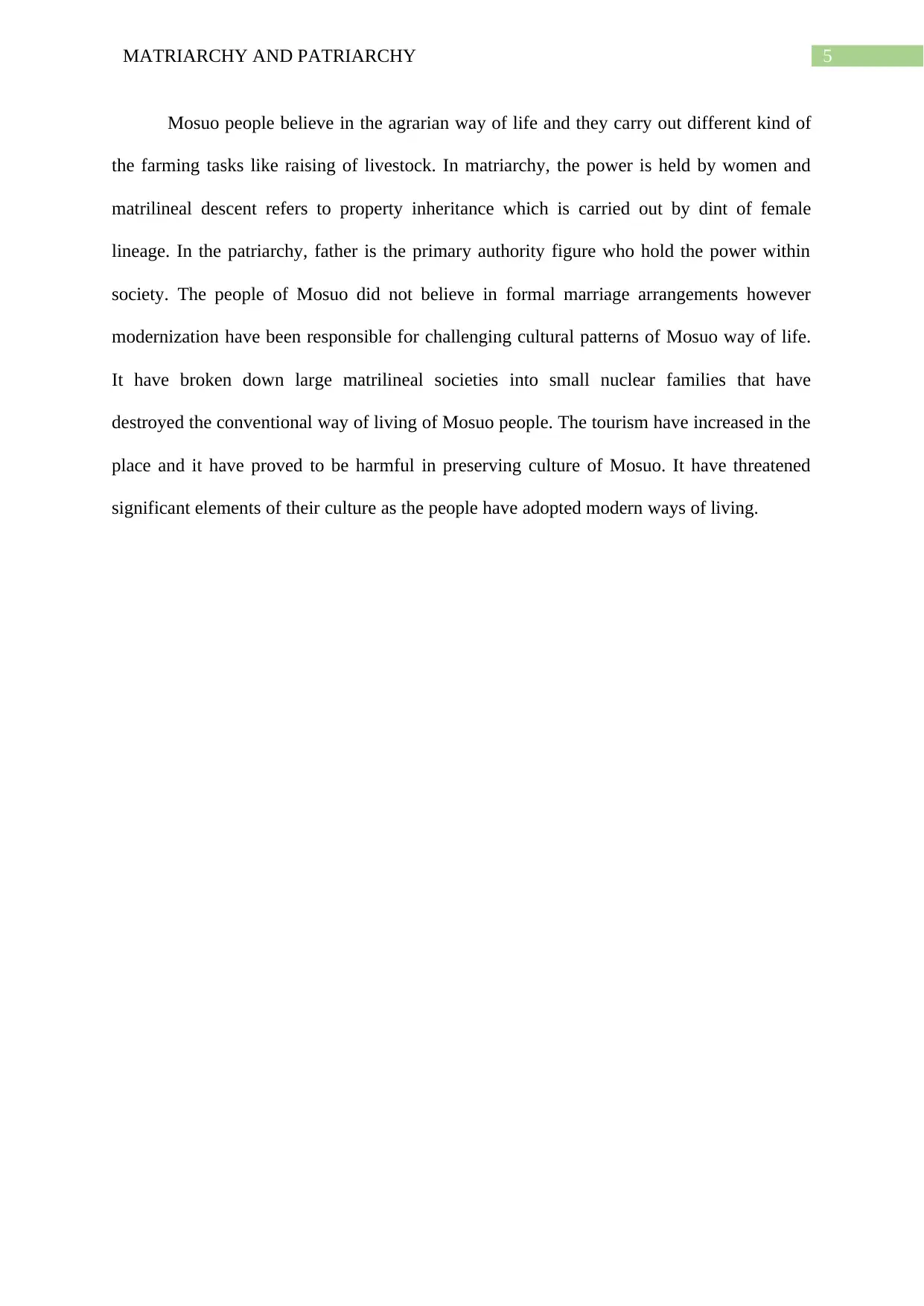
5MATRIARCHY AND PATRIARCHY
Mosuo people believe in the agrarian way of life and they carry out different kind of
the farming tasks like raising of livestock. In matriarchy, the power is held by women and
matrilineal descent refers to property inheritance which is carried out by dint of female
lineage. In the patriarchy, father is the primary authority figure who hold the power within
society. The people of Mosuo did not believe in formal marriage arrangements however
modernization have been responsible for challenging cultural patterns of Mosuo way of life.
It have broken down large matrilineal societies into small nuclear families that have
destroyed the conventional way of living of Mosuo people. The tourism have increased in the
place and it have proved to be harmful in preserving culture of Mosuo. It have threatened
significant elements of their culture as the people have adopted modern ways of living.
Mosuo people believe in the agrarian way of life and they carry out different kind of
the farming tasks like raising of livestock. In matriarchy, the power is held by women and
matrilineal descent refers to property inheritance which is carried out by dint of female
lineage. In the patriarchy, father is the primary authority figure who hold the power within
society. The people of Mosuo did not believe in formal marriage arrangements however
modernization have been responsible for challenging cultural patterns of Mosuo way of life.
It have broken down large matrilineal societies into small nuclear families that have
destroyed the conventional way of living of Mosuo people. The tourism have increased in the
place and it have proved to be harmful in preserving culture of Mosuo. It have threatened
significant elements of their culture as the people have adopted modern ways of living.
⊘ This is a preview!⊘
Do you want full access?
Subscribe today to unlock all pages.

Trusted by 1+ million students worldwide
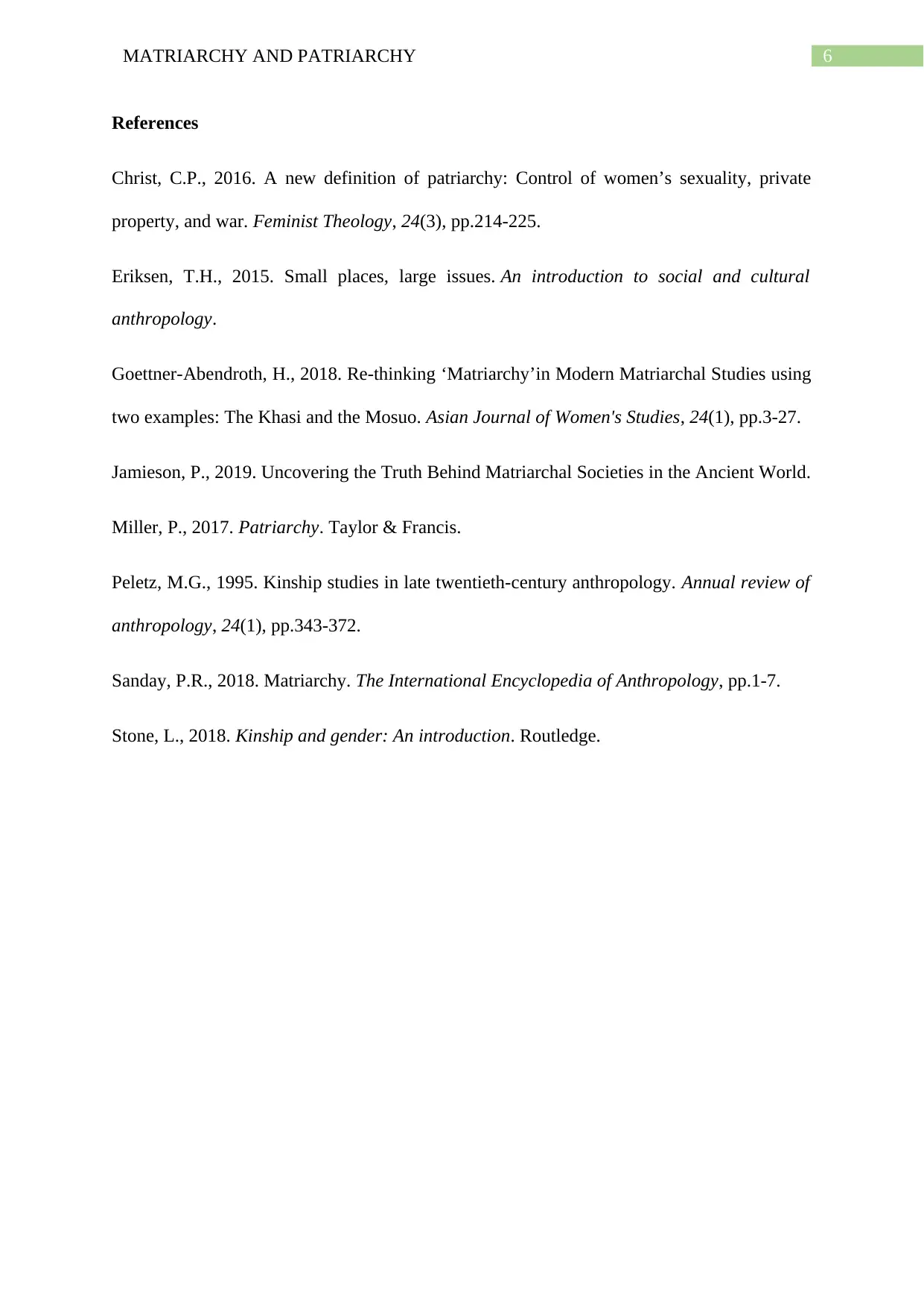
6MATRIARCHY AND PATRIARCHY
References
Christ, C.P., 2016. A new definition of patriarchy: Control of women’s sexuality, private
property, and war. Feminist Theology, 24(3), pp.214-225.
Eriksen, T.H., 2015. Small places, large issues. An introduction to social and cultural
anthropology.
Goettner-Abendroth, H., 2018. Re-thinking ‘Matriarchy’in Modern Matriarchal Studies using
two examples: The Khasi and the Mosuo. Asian Journal of Women's Studies, 24(1), pp.3-27.
Jamieson, P., 2019. Uncovering the Truth Behind Matriarchal Societies in the Ancient World.
Miller, P., 2017. Patriarchy. Taylor & Francis.
Peletz, M.G., 1995. Kinship studies in late twentieth-century anthropology. Annual review of
anthropology, 24(1), pp.343-372.
Sanday, P.R., 2018. Matriarchy. The International Encyclopedia of Anthropology, pp.1-7.
Stone, L., 2018. Kinship and gender: An introduction. Routledge.
References
Christ, C.P., 2016. A new definition of patriarchy: Control of women’s sexuality, private
property, and war. Feminist Theology, 24(3), pp.214-225.
Eriksen, T.H., 2015. Small places, large issues. An introduction to social and cultural
anthropology.
Goettner-Abendroth, H., 2018. Re-thinking ‘Matriarchy’in Modern Matriarchal Studies using
two examples: The Khasi and the Mosuo. Asian Journal of Women's Studies, 24(1), pp.3-27.
Jamieson, P., 2019. Uncovering the Truth Behind Matriarchal Societies in the Ancient World.
Miller, P., 2017. Patriarchy. Taylor & Francis.
Peletz, M.G., 1995. Kinship studies in late twentieth-century anthropology. Annual review of
anthropology, 24(1), pp.343-372.
Sanday, P.R., 2018. Matriarchy. The International Encyclopedia of Anthropology, pp.1-7.
Stone, L., 2018. Kinship and gender: An introduction. Routledge.
1 out of 7
Your All-in-One AI-Powered Toolkit for Academic Success.
+13062052269
info@desklib.com
Available 24*7 on WhatsApp / Email
![[object Object]](/_next/static/media/star-bottom.7253800d.svg)
Unlock your academic potential
Copyright © 2020–2025 A2Z Services. All Rights Reserved. Developed and managed by ZUCOL.
![Domestic Violence: Mental Health in Nursing, [University Name] Report](/_next/image/?url=https%3A%2F%2Fdesklib.com%2Fmedia%2Fdomestic-violence-mental-health-nursing_page_2.jpg&w=256&q=75)